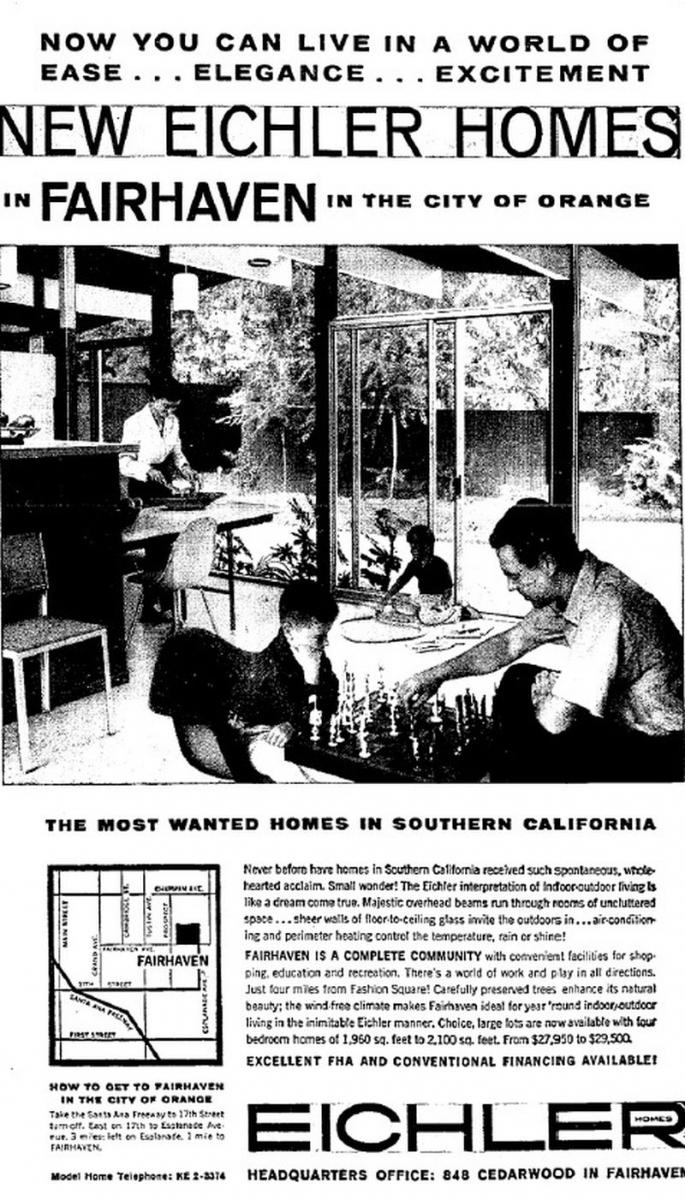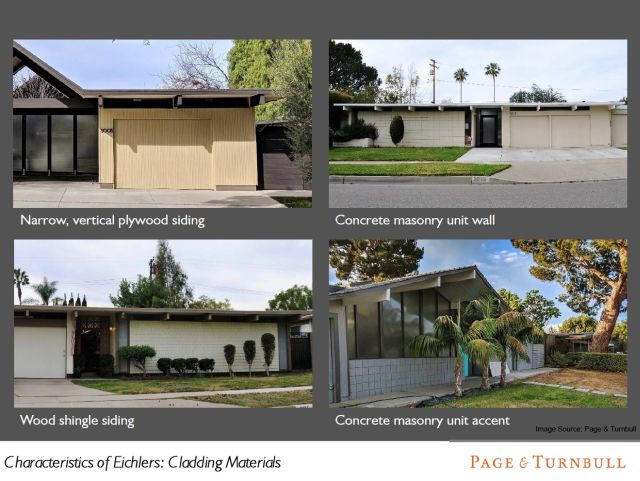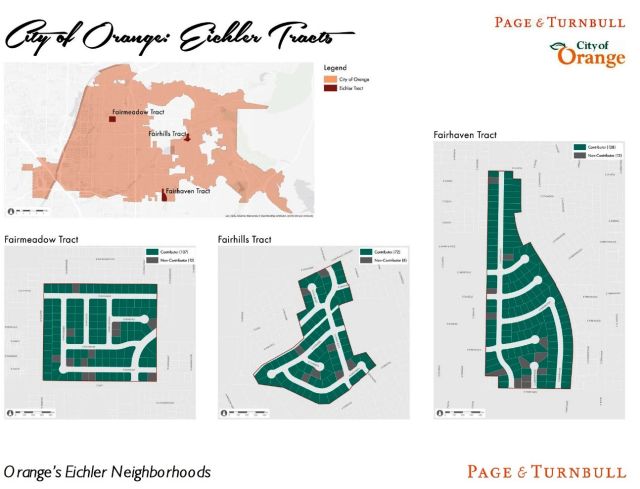
Orange Develops Rules to Protect Eichlers
 |
|
|
It was about 15 years ago that folks who live in three far-flung but beautifully preserved Eichler neighborhoods came up with a thought – what if we became a historic district?
Now that goal seems likely to happen and with it will come some intriguing consequences. One would be the imposition of rules to preserve the looks of existing homes. The other would be significant tax relief for people who need to maintain the exteriors of their homes and their homes’ plumbing, electrical, and radiant heating.
And just exactly who doesn’t, with homes that were built in the 1960s?
On May 3, the second community meeting will be held to gather input from owners of the 350 or so homes that make up three Eichler tracts in the city of Orange, in Southern California.
Orange may be a distance from Eichler Central, which is Palo Alto and the Bay Area, but Eichler owners in Orange appreciate what they have.
 |
|
|
Looking at the 350 homes there, almost every one remains intact enough from the outside to 'contribute' to a historic district. “There are only a handful of non-contributors in each of the tracts,” says Marissa Moshier, a city planner who oversees historic preservation in the preservation-minded city.
Moshier and Anna Pehoushek, the assistant community development director, say the schedule calls for the City Council to make its decision in December.
“Our intent is to take both the plan for the historic district and standards to City Council at the same time,” she says.
The district and accompanying rules could be in place by February. The three tracts are Fairhaven, Fairhills, and Fairmeadow.
The questions before the council are: Should Orange make all three Eichler tracts historic, adopting zoning overlays to do so? And should it adopt the 'design standards' being developed for the tracts by the architectural firm Page & Turnbull?
 |
|
|
(This is the same firm, by the way, that developed the recently adopted Eichler guidelines in Palo Alto.)
The results in Orange could be very different than those in Palo Alto, however. In Palo Alto, the council adopted guidelines that are purely advisory, with no regulatory teeth (although neighborhoods are free to adopt stronger rules on their own).
In Orange, on the other hand, Moshier says, there is likely to be some city enforcement of design rules.
“Our approach at this moment is, they are design standards with a range of flexibility built into those standards. There will be some ‘shall’ language, but many more that are ‘should.’”
Simple changes to homes would be overseen by city staff. More substantial changes would go to the design review committee.
Pehoushek adds, “We want to have a certain level of regulatory control, but not make it so burdensome that it undercuts efforts to protect the neighborhoods.”
“We want feedback from the neighborhoods,” Moshier says, mentioning other occasions for neighbors to comment. In addition, an Eichler advisory committee has met with city officials four times to provide input.
“People in that group have different perspectives, from the purist to people who prefer more flexibility about what a modern-day Eichler might look like,” Pehoushek says, adding that there are “people with divergent perspectives on whether a historic district is a good thing. We didn’t want a group that shared a single perspective. We wanted a typical homeowner who has been there a long time, and some who bought there more recently because it was an Eichler.”
More than 100 people attended a community workshop in February.
 |
|
|
Pehoushek says, “There is some anxiety in the neighborhoods. Some are anxious that it could be like a homeowners association with CCRs. We want to allow a little bit of flexibility.”
But there is also optimism in the tracts, not only because people love their homes and their integrity, but because the city of Orange, known for another historic district, the early 20th century Olde Towne, is particularly generous when it comes to signing Mills Act contracts.
“We have heard from people in the neighborhoods who are very interested in the potential for the Mills Act,” Moshier says.
These are deals that, under state law, can reduce a homeowner’s property tax bill significantly – some homes in Old Towne purchased within the past decade, for example, see a 30-40 percent drop in property tax bills – for owners who use the saving to improve their homes’ exteriors and systems.
“All the money you save you are supposed to spend on maintaining the house in a historically appropriate way,” Pehoushek says.
A year and a half ago the city upped the number of such contracts it would approve each year from 10 to – unlimited. “This was in response to demands from Old Towne and anticipation of the Eichler neighborhoods coming online,” Moshier says.
 |
|
|
The contract is for 10 years but rolls over automatically. The contracts call for owners to perform a “scope of work,” and Moshier says, “We take a look at it and make sure they meet the preservation standards.”
Tax savings cannot be used for such things as bedroom additions or kitchen remodels. And interiors of homes are not reviewed for compliance with historic standards under Mills Act contracts.
The Mills Act in Orange’s Eichlers, Moshier says, will be “particularly beneficial to people who know they will be doing a lot of work on their house and are budgeting for that.” “The only people who wouldn’t find much advantage [from the act] are some longtime or original owners, and we have original owners, whose property taxes are so low,” Pehoushek says.
The situation is quite different in Palo Alto. “We have only one Mills Act Contract in place, the Squire House at 900 University Avenue,” says planning manager Amy French, meaning a Roman Revival mansion. “Our program as such is not developed as in other cities. Our [Historic Resources Board] members are interested, and there is a subcommittee working on getting a program together. But it is unlikely Eichlers would be Mills Act contracts. They are not on our historic inventory.”
Another incentive in Orange to having a home in a historic neighborhood would be that the state historic building code kicks in. That could help, Moshier says, for people dealing with “energy requirements that are difficult to do in an Eichler if you are taking a preservation approach,” for example, windows. “Some of the energy requirements are relaxed to allow for preservation.”
Getting to this point with the historic district has been a long process. The city, working with some residents who hoped to place the tracts on the National Register, began surveying the homes back in early 2015. The National Register effort has fallen onto the back burner while efforts move forward with local designation.
- ‹ previous
- 448 of 677
- next ›



